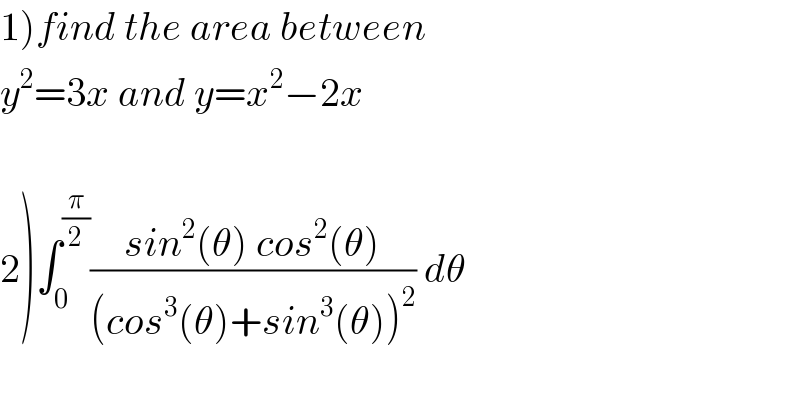
Question Number 85195 by M±th+et£s last updated on 19/Mar/20

$$\left.\mathrm{1}\right){find}\:{the}\:{area}\:{between} \\ $$$${y}^{\mathrm{2}} =\mathrm{3}{x}\:{and}\:{y}={x}^{\mathrm{2}} −\mathrm{2}{x} \\ $$$$ \\ $$$$\left.\mathrm{2}\right)\int_{\mathrm{0}} ^{\frac{\pi}{\mathrm{2}}} \frac{{sin}^{\mathrm{2}} \left(\theta\right)\:{cos}^{\mathrm{2}} \left(\theta\right)}{\left({cos}^{\mathrm{3}} \left(\theta\right)+{sin}^{\mathrm{3}} \left(\theta\right)\right)^{\mathrm{2}} }\:{d}\theta \\ $$
Answered by Rio Michael last updated on 19/Mar/20
![at intersection (x^2 −2x)^2 = 3x (x^4 −2(2x^3 )+4x^2 ) = 3x x^4 −4x^3 +4x^2 −3x = 0 ⇒ x = 0 or x = 3 Area A = ∫_a ^b [f(x)−g(x)] dx = ∫_0 ^3 [(√3) (√x) − (x^2 −2x)]dx = ∫_0 ^3 [(√3) x^(1/2) −x^2 + 2x] = ((2(√3))/3) x^(3/2) −(x^3 /3) + x^2 ]_0 ^3 A = ((2(√3))/3)(√(27)) − 9 + 9 = 6sq units](Q85208.png)
$$\:\mathrm{at}\:\mathrm{intersection} \\ $$$$\:\:\:\left({x}^{\mathrm{2}} −\mathrm{2}{x}\right)^{\mathrm{2}} \:=\:\mathrm{3}{x} \\ $$$$\:\:\left({x}^{\mathrm{4}} −\mathrm{2}\left(\mathrm{2}{x}^{\mathrm{3}} \right)+\mathrm{4}{x}^{\mathrm{2}} \right)\:=\:\mathrm{3}{x} \\ $$$$\:\:\:\:{x}^{\mathrm{4}} −\mathrm{4}{x}^{\mathrm{3}} +\mathrm{4}{x}^{\mathrm{2}} −\mathrm{3}{x}\:=\:\mathrm{0} \\ $$$$\Rightarrow\:{x}\:=\:\mathrm{0}\:\mathrm{or}\:{x}\:=\:\mathrm{3} \\ $$$${Area}\:{A}\:=\:\int_{{a}} ^{{b}} \left[{f}\left({x}\right)−{g}\left({x}\right)\right]\:{dx}\:=\:\int_{\mathrm{0}} ^{\mathrm{3}} \left[\sqrt{\mathrm{3}}\:\sqrt{{x}}\:−\:\left({x}^{\mathrm{2}} −\mathrm{2}{x}\right)\right]{dx} \\ $$$$\left.\:\:\:\:\:\:\:\:\:\:\:\:\:\:\:\:\:\:\:\:\:\:\:\:\:\:\:\:\:\:\:\:\:\:\:\:\:\:\:\:\:\:\:\:\:\:\:\:\:\:\:\:\:\:\:\:\:\:=\:\int_{\mathrm{0}} ^{\mathrm{3}} \:\left[\sqrt{\mathrm{3}}\:{x}^{\frac{\mathrm{1}}{\mathrm{2}}} \:−{x}^{\mathrm{2}} \:+\:\mathrm{2}{x}\right]\:=\:\frac{\mathrm{2}\sqrt{\mathrm{3}}}{\mathrm{3}}\:{x}^{\frac{\mathrm{3}}{\mathrm{2}}} \:−\frac{{x}^{\mathrm{3}} }{\mathrm{3}}\:+\:{x}^{\mathrm{2}} \right]_{\mathrm{0}} ^{\mathrm{3}} \\ $$$$\:\:\:{A}\:=\:\frac{\mathrm{2}\sqrt{\mathrm{3}}}{\mathrm{3}}\sqrt{\mathrm{27}}\:−\:\mathrm{9}\:+\:\mathrm{9}\:=\:\:\mathrm{6sq}\:\mathrm{units} \\ $$
Commented by M±th+et£s last updated on 19/Mar/20

$${thank}\:{you}\:{sir} \\ $$
Answered by mr W last updated on 19/Mar/20

$$\left(\mathrm{1}\right) \\ $$$${Area}=\mathrm{3}×\mathrm{4}−\frac{\mathrm{3}×\mathrm{3}}{\mathrm{3}}−\frac{\mathrm{1}×\mathrm{1}}{\mathrm{3}}−\frac{\mathrm{2}×\mathrm{4}}{\mathrm{3}}=\mathrm{6} \\ $$
Commented by M±th+et£s last updated on 19/Mar/20

$${thank}\:{you}\:{sir} \\ $$
